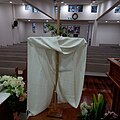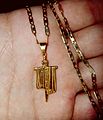Drabsha

| Part of a series on |
| Mandaeism |
|---|
 |
| Religion portal |
The drabsha
Etymology
The Mandaic term drabša is derived from the Middle Persian word drafš, which means 'banner or standard; a flash of light; sunrise'. In Mandaic, drabša can also mean 'a ray or beam of light'.[5]
Description and symbolism
The drabša is a banner in the shape of a cross made of two branches of olive wood fastened together and half covered with a piece of white cloth traditionally made of pure silk, and seven branches of myrtle. The drabša white silk banner is not identified with the Christian cross. Instead, the four arms of the drabsha symbolize the four corners of the universe, while the pure silk cloth represents the Light of God (Hayyi Rabbi).[6] The seven branches of myrtle represent the seven days of creation.[7][8] The drabsha is viewed as a symbol of light and the light of the sun, moon and stars is envisaged to shine from it.[9] It may be of pre-Christian origin and used originally to hang a prayer shawl during immersion in the river (masbuta).[9]
Prayers
In E. S. Drower's version of the Qolasta, prayers 330–347 (corresponding to Part 4 of Mark Lidzbarski's Oxford Collection) are dedicated to the drabša. In many of these prayers, which mention the unfurling of drabshas, individual drabshas have given names.[10]
- Šišlamiel (various prayers)
- Šašlamiel (prayer 347)
- Manhariel (prayer 334)
- Pirun (prayer 333) (also the name of a gufna)
- Zihrun (prayers 332, 340, 341, 374)
Gallery
-
Artistic rendition of the Mandaean drabsha
-
An actual drabsha (left) next to a symbolic drabsha (center) at theLiverpool, Sydney, Australia
-
Front side of a drabsha at theLiverpool, Sydney, Australia
-
Back side of a drabsha at theLiverpool, Sydney, Australia
-
A drabsha (center) carried during a Parwanaya festival held in Maysan Governorate, southern Iraq in March 2019
-
A drabsha being carried to the Tigris River
-
A drabsha (darfash) golden necklace
See also
- Kushta
- Rasta (Mandaeism), white ritual clothing used by Mandaeans
- Temple menorah, represents light of God and symbolizes creation in seven days
References
- OCLC 65198443.
- ^ Drower, Ethel Stefana (1937). The Mandaeans of Iraq and Iran. Oxford at the Clarendon Press.
- ISBN 9780958034630.
- .
- OCLC 1149751154.
- ^ Mite, Valentinas (14 July 2004). "Iraq: Old Sabaean-Mandean Community is Proud of Its Ancient Faith". Radio Free Europe/Radio Liberty. Retrieved 4 November 2021.
- ^ Holy Spirit University of Kaslik - USEK (27 November 2017). "Open discussion with the Sabaeans Mandaeans". YouTube. Retrieved 9 November 2021.
- ^ Sly, Liz (16 November 2008). "'This is one of the world's oldest religions, and it is going to die.'". Chicago Tribune. Retrieved 9 November 2021.
- ^ a b Mandaean Awareness and Guidance Board (28 May 2014). "Mandaean Beliefs & Mandaean Practices". Mandaean Associations Union. Retrieved 10 November 2021.
- ^ Drower, E. S. (1959). The Canonical Prayerbook of the Mandaeans. Leiden: E. J. Brill.
External links
- Preparing the drabsha (video)










